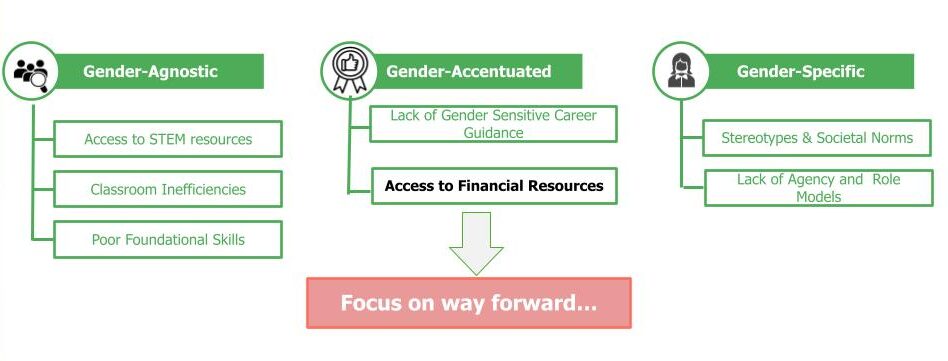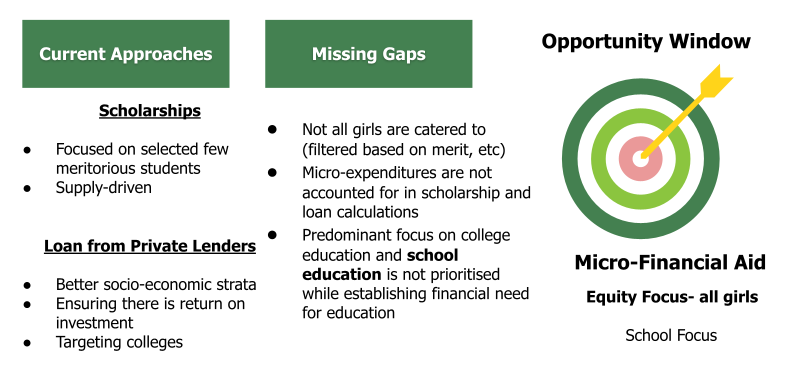The Education Practice Area under the Sattva Knowledge Institute conducted a Communities of Practice (CoP) session, which focused on the role of micro-financial aid in enabling the uptake of STEM subjects among school girls in India. The session gathered a cohort of leaders and practitioners spanning various sectors, all sharing a common focus on accelerating inclusion in future opportunities across gender groups in India.
The objectives of the CoP were to:
- Recognise the nuanced regional micro-financial needs that inhibit girls from pursuing STEM education in eight lagging states.
- Establish clear and equitable criteria and processes for selecting beneficiaries of micro-financial aid, ensuring that the support reaches the girls who need it most, especially in economically disadvantaged regions.
- Collaborate to create efficient and scalable processes for distributing micro-financial aid, focusing on minimising transaction costs and ensuring accessibility for all eligible girls pursuing STEM education.
Education drives societal progress and alleviates intergenerational poverty. Yet, access to quality education in India remains uneven, especially for girls in STEM fields. 80% of future jobs will require STEM skills. However, only 37% of Indian girls graduate with STEM subjects, and the proportion is as low as 11% in states like West Bengal, Haryana, and Odisha. The underrepresentation of girls in STEM is a result of systemic barriers. Therefore, targeted interventions are necessary to address the gender gap in STEM education. Our work focuses on eight states (West Bengal, Haryana, Jharkhand, Gujarat, Punjab, Rajasthan, Odisha, and Bihar) with the lowest participation of girls in STEM education.
SKI’s research categorised the challenges impeding the uptake of STEM among girls into three broad areas:

Addressing gender-accentuated financial constraints was positioned as an appropriate avenue for the group to invest their efforts. There exist gender disparities in educational spending, with less investment in girls’ education compared to boys’. STEM education is significantly costlier than humanities – 139% more in urban areas and 58% more in rural areas – and NSS data reveals financial barriers contribute to a 22% dropout rate. Thus, enabling financial support emerged as a scalable solution to enable girls into STEM fields.
Scholarships, subsidies, loans, and other financial support were recognised as tools to ease the financial burden, benefiting students and the educational system.
Two primary support systems exist to help marginalised girls overcome financial barriers: scholarships and loans. However, these systems have limitations.
- Scholarships are mainly merit-based, often at the college level, with lengthy application processes and delayed disbursements.
- Formal loans, requiring credit history and collateral, are mainly accessible only to those with higher socio-economic status, leaving many without adequate financial support for school education. While these supports cover significant expenses like tuition and housing, they often exclude essential costs such as textbooks, extra classes, and transportation— which are critical barriers for girls pursuing STEM.
While existing support systems like scholarships and loans cater to a selected few, often based on merit or socioeconomic status, they fail to address the broader financial needs of many marginalised girls. The group reiterated the need for small, sachet-sized financial support from an equity lens. This approach would ensure that all girls, regardless of their background, have the opportunity to overcome financial barriers and succeed in STEM education.

The group identified three main issues: defining girls’ financial needs, identifying target beneficiaries, and incorporating diverse stakeholder perspectives.
Along with key aid instruments such as scholarships and fee waivers, support mechanisms such as remedial education were deemed necessary. To manage regional variations in need, the proposal included categorising needs into “buckets” and defining them through local NGOs or governments, emphasising local insights and sample surveys. Participants brought attention to enabling holistic child development, identifying states that are not providing free and compulsory education till grade 10 and 12th, and designing solutions accordingly. Some participants also emphasised engagement with parents to ensure right utilisation and impact of the financial support in the desired direction.
The criteria for micro-financial aid eligibility were debated, with a preference for focusing on government school girls to target low-income groups and simplify the process. Consideration was given to including attendance and academic performance in the selection process. It was also suggested that there should be no boundary conditions beyond school enrollments for the disbursement of micro-financial aid to girls.
The group also devoted attention to stakeholder integration and supply-side narratives – effective micro-financial aid required collaboration among technology enablers for scholarship management, intermediaries for tailored solutions, innovative microfinance enablers, ecosystem enablers for stakeholder coordination, and last-mile NGOs for student identification and validation.
The group also acknowledged that funders often need more visibility into on-ground needs, leading to less effective financial support. A strategic, evidence-based approach is needed, involving tailored financial instruments and collaboration among funders, financial aid providers, NGOs, schools, and beneficiaries. Scalable technology is essential to connect and facilitate aid distribution effectively.
Facilitating micro-financial aid requires the integration of technology to ensure seamless stakeholder coordination and process efficiency, which, in turn, is crucial for scaling and transparency. The current financial aid system is ridden by several challenges, including:
- Complex application processes for financial support
- Delays in disbursement
- High transaction costs
To address these issues, the group agreed that any proposed solution must focus on five key elements:
- Process simplification: Streamlining application and disbursement processes to ensure aid reaches suitable candidates efficiently.
- Generating a demand-side view: Understanding and addressing the specific sub-10K needs of beneficiaries.
- Enhancing transparency: Allowing stakeholders to monitor fund usage, thereby fostering accountability and trust.
- Leveraging technology: Utilising advanced systems to make financial aid accessible and scalable across states.
- Optimising time and cost efficiency: Reducing delays and minimising expenses in aid distribution.
The technology-led approach to financial aid disbursement would involve:
- Technology enablers providing platforms for managing payments and disbursement gateways.
- Intermediaries designing tailored micro-financial aid packages.
- Last-mile NGOs identifying and validating beneficiaries.
Additionally, incorporating beneficiaries into the process, as demonstrated by Navgurukul’s ‘paying it forward’ approach, enhances sustainability by enabling recipients to assist future aid seekers. These measures collectively address both supply and demand challenges, ensuring that micro-financial aid supports schoolgirls in a streamlined, impactful, and sustainable manner.
One of the primary focuses of SKI is developing impactful, scalable solutions. Our approach includes:
- Generating Evidence – Conducting comprehensive data collection and analysis in selected states to understand girls’ financial needs and systemic barriers, by engaging local stakeholders such as schools, girls, parents, aid providers, and nonprofits. Designing solutions for captured micro-financial needs.
- Leveraging Technology – Leveraging the existing digital public infrastructure like ONEST by EkStep Foundation to facilitate efficient aid disbursement.
- Orchestrating and Scaling – Launching a proof of concept in two states, refining the same based on the lessons, and scaling the solution to all eight lagging states.
By combining real-world insights with advanced technology, we aim to create a scalable and inclusive system that supports schoolgirls pursuing STEM education across diverse regions. We will build on session inputs and identify collaborative opportunities to optimise the effectiveness of micro-financial aid solutions.




